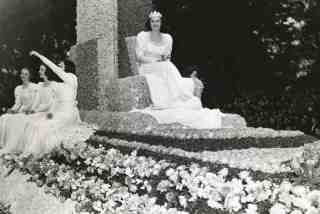Death Finally Separates Two of Tennis’ Great Rivals
- Share via
PARIS — Sixty-seven years ago Helen Jacobs chased Helen Wills Moody across the Atlantic to the French Championships. They were the two Helens whose exploits were American sports page staples during the 1920s and ‘30s, when they were known as The Rivals.
The confrontations between Moody and Jacobs, though not so frequent, drew as much attention as the latter-day Chris Evert-Martina Navratilova serial. Seven of them came in major finals, four at Wimbledon, and Jacobs won only one, the U.S. final of 1933. Her 1930 voyage to Paris resulted in a 6-2, 6-1 championship loss to Moody.
Their lives and careers were closely entwined yet they seldom spoke to each other, shook hands only across a tennis net, and were portrayed by the press as participants in a feud that both insisted didn’t exist. “She was older than I,” Jacobs said. “We weren’t friends, that’s all. There was no antagonism.”
But who wanted to spoil a good story by sticking to facts? The last fact is that Helen Hull Jacobs, a great player, though second fiddle to possibly the greatest, has been outlasted by her old antagonist once more. Jacobs, two months short of her 89th birthday, died Monday at East Hampton, N.Y., while the other Helen, 91, survives in a Carmel nursing home.
Both Helens came from Berkeley, attended the University of California, played at the same club, had the same coach, Pop Fuller. When the Wills family vacated a Berkeley home, the Jacobs family moved in.
Jacobs may have believed she had the misfortune to be a contemporary of Helen Wills Moody, but she never expressed it. Sturdy, dark-haired, quietly but highly competitive, she did just fine, apart from shadowing Moody, in creating a Hall of Fame career for herself over 15 years, 11 of them in the world top 10, five at No. 2 behind Moody. She won Wimbledon in 1936 to gain No. 1, and the U.S. singles from 1932-35. Only she, Molla Mallory (1915-18) and Chris Evert (1975-78) seized that title in four consecutive years.
Her daring as a superb volleying attacker seemed matched in 1933 by her nerve in introducing what was considered an outrageous article of clothing for a woman on the court: shorts. Thought racy at the time, her baggy shorts were identical to those worn by Pete Sampras today--knee-length with a navy stripe on either side.
That year she found her promised land on the lawn at Forest Hills, at last beating the baselining Moody in the U.S. final. It was her lone triumph in 11 shots at Wills, but even that wasn’t too satisfactory. At 3-3 in the third set, Wills walked out, defaulting, pleading back pains, even though Jacobs said she would grant her foe a rest period.
Two years later, in the 1935 Wimbledon final, Jacobs came closest to the real thing: a match point in the third set. Moody lofted a desperate short lob, but as Jacobs prepared to smash it, a sudden gust of wind whisked the ball away from her. Trying to follow it, she ended on her knees tapping it into the net.
More to Read
Go beyond the scoreboard
Get the latest on L.A.'s teams in the daily Sports Report newsletter.
You may occasionally receive promotional content from the Los Angeles Times.










